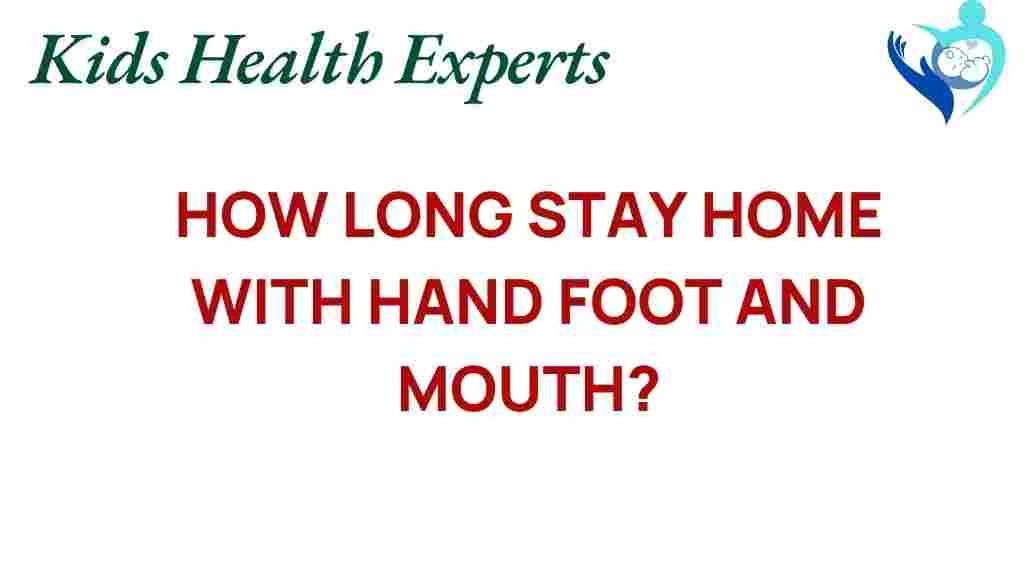How Long Should You Stay Home with Hand, Foot, and Mouth Disease?
Hand, Foot, and Mouth Disease (HFMD) is a common viral infection that primarily affects children, particularly those under the age of five. Caused by viruses like coxsackievirus, it is characterized by fever, sores in the mouth, and a rash on the hands and feet. Understanding the symptoms, contagious period, recovery time, and effective prevention strategies can help you manage this illness when it strikes your family.
Understanding Hand, Foot, and Mouth Disease
Hand, Foot, and Mouth Disease is not the same as foot-and-mouth disease, which affects livestock. HFMD is generally mild but can be uncomfortable for young children. The condition is highly contagious, spreading easily through close contact, respiratory droplets, and contaminated surfaces.
Symptoms of Hand, Foot, and Mouth Disease
The symptoms of Hand, Foot, and Mouth Disease usually appear three to seven days after exposure to the virus. They often include:
- Fever
- Sore throat
- Painful sores in the mouth (especially on the tongue and inside of the cheeks)
- Red rash on the hands and feet (may develop into blisters)
- Irritability in young children
- Loss of appetite
Most children recover from Hand, Foot, and Mouth Disease within a week to ten days, but it’s important to monitor their symptoms closely.
How Contagious is Hand, Foot, and Mouth Disease?
HFMD is highly contagious, particularly in the first week of illness. The virus can spread through:
- Direct contact with an infected person’s blister or saliva
- Respiratory droplets from coughing or sneezing
- Contaminated surfaces and objects
Children can spread the virus even before they show symptoms and until the sores have healed. This makes it crucial for parents to take precautions, particularly in communal settings like daycare or school.
When Should You Keep Your Child Home?
If your child has been diagnosed with Hand, Foot, and Mouth Disease, it is recommended to keep them home to prevent spreading the virus to others. Here are some guidelines:
- During the fever: Keep your child home until their fever has subsided for at least 24 hours without the use of fever-reducing medications.
- Until sores heal: Children should remain at home until all mouth sores have healed, and any rashes are crusted over.
- Consult with your pediatrician: If you are unsure, consult your doctor for specific advice based on your child’s symptoms.
Recovery from Hand, Foot, and Mouth Disease
Recovery from Hand, Foot, and Mouth Disease can vary from child to child. Here are some typical recovery milestones:
- First 3-5 days: Most children will experience fever and mouth sores.
- Days 5-7: Fever will typically resolve, but mouth sores may persist.
- Days 7-10: By the end of the week, most symptoms should improve, and children can return to their normal activities.
It is important to monitor your child for any complications, such as dehydration, which can occur if they are unable to drink due to mouth sores.
Home Care for Hand, Foot, and Mouth Disease
While there is no specific treatment for Hand, Foot, and Mouth Disease, you can manage symptoms at home:
- Stay Hydrated: Encourage your child to drink plenty of fluids to prevent dehydration.
- Pain Relief: Over-the-counter medications like acetaminophen can help relieve pain and fever. Always consult your pediatrician before administering any medication.
- Soothing Foods: Offer soft, bland foods that are easy to swallow. Avoid acidic or spicy foods that may irritate mouth sores.
- Cold Compresses: Apply cold packs to blisters and rashes to reduce discomfort.
Prevention of Hand, Foot, and Mouth Disease
Preventing Hand, Foot, and Mouth Disease involves good hygiene practices and awareness of the contagious nature of the virus. Here are some effective prevention strategies:
- Hand Hygiene: Encourage frequent handwashing with soap and water, especially after using the restroom and before meals.
- Clean Surfaces: Regularly disinfect toys, surfaces, and any items that may come into contact with saliva or mucus.
- Avoid Close Contact: Keep children away from others who are sick and avoid sharing utensils or cups.
- Stay Home When Sick: If your child is diagnosed with HFMD, keep them home to prevent spreading the virus.
For more detailed information on hygiene practices, you can visit the CDC’s website.
Troubleshooting Tips
Here are some common concerns and troubleshooting tips for parents dealing with Hand, Foot, and Mouth Disease:
- Concern: My child refuses to drink fluids.
Tip: Offer popsicles or ice chips, which are often easier to consume than liquids. - Concern: The rash appears severe.
Tip: Consult your pediatrician if the rash worsens or if you notice signs of infection. - Concern: Symptoms are not improving.
Tip: If your child’s condition does not improve after a week, seek medical advice.
Conclusion
In conclusion, Hand, Foot, and Mouth Disease is a common illness among children, and while it can be uncomfortable, it is typically mild and self-limiting. The key elements in managing this illness include understanding the symptoms, knowing when your child is contagious, and implementing effective home care measures. Staying home during the infectious period is crucial to prevent spreading the virus to others.
By practicing good hygiene, monitoring your child’s symptoms, and providing appropriate care, you can help your child recover swiftly and comfortably from Hand, Foot, and Mouth Disease. If you have any concerns, always consult with your healthcare provider for guidance tailored to your child’s needs.
For more information on child health and disease prevention, consider visiting resources like HealthyChildren.org.
This article is in the category Conditions and created by KidsHealthExperts Team
